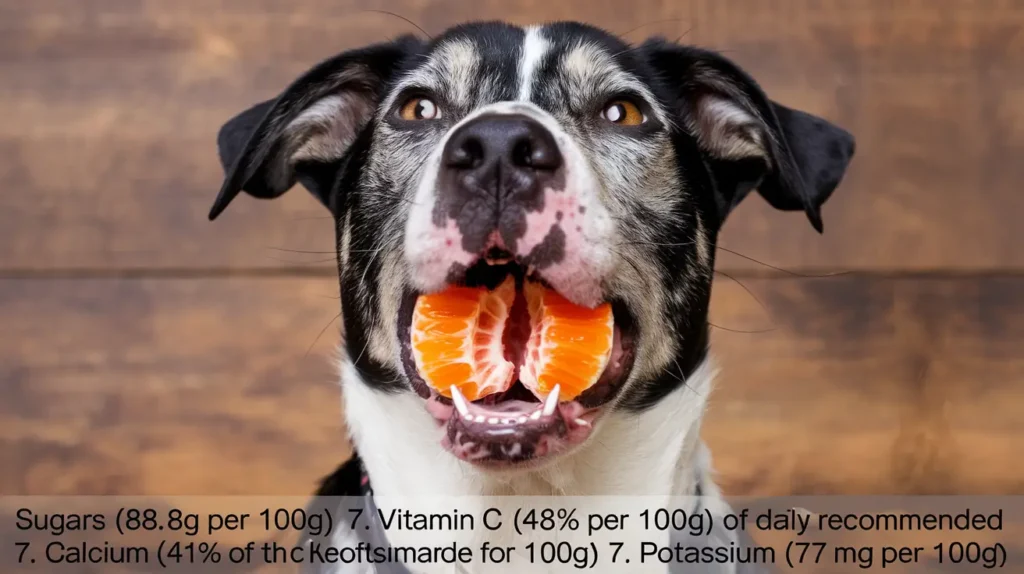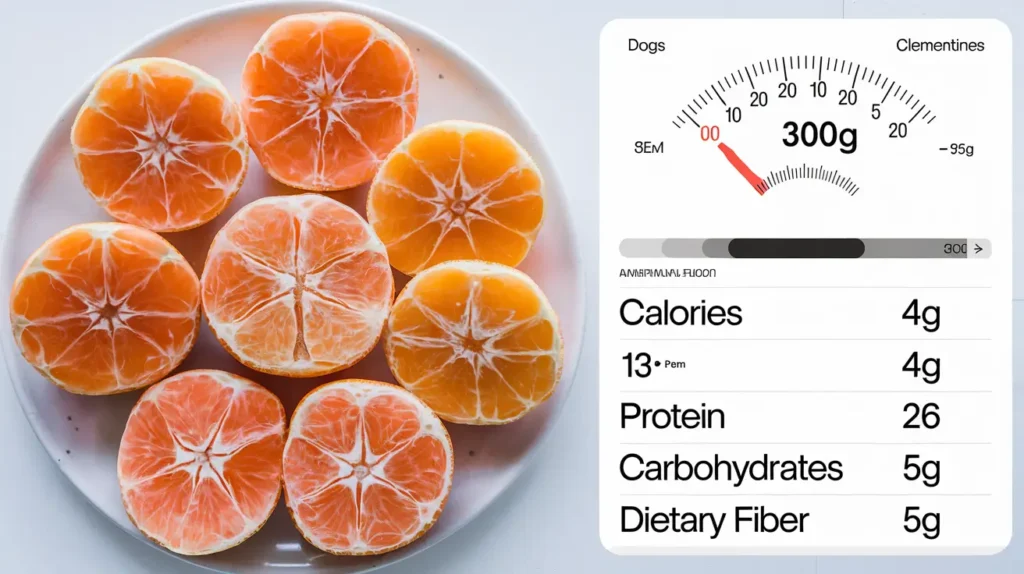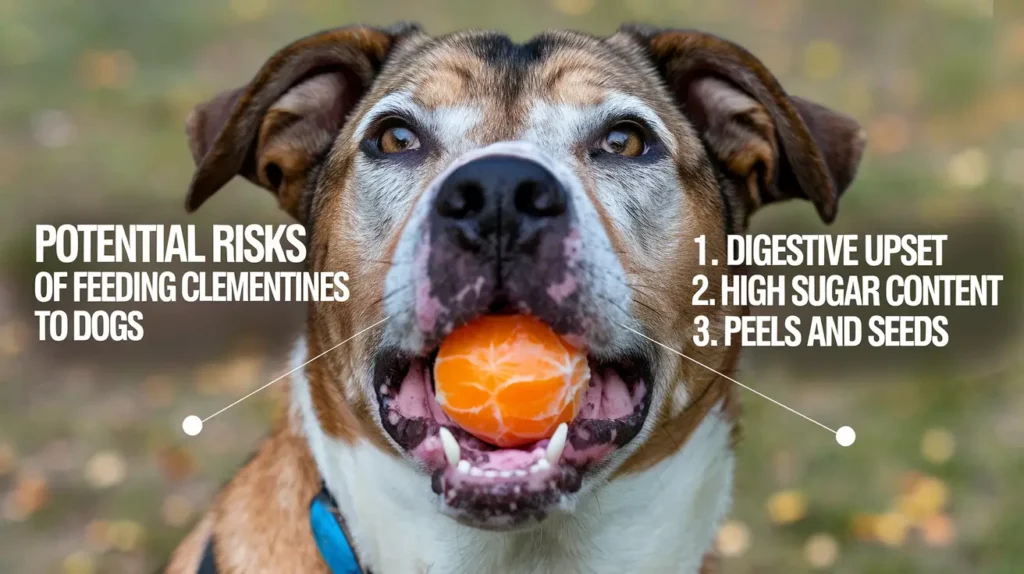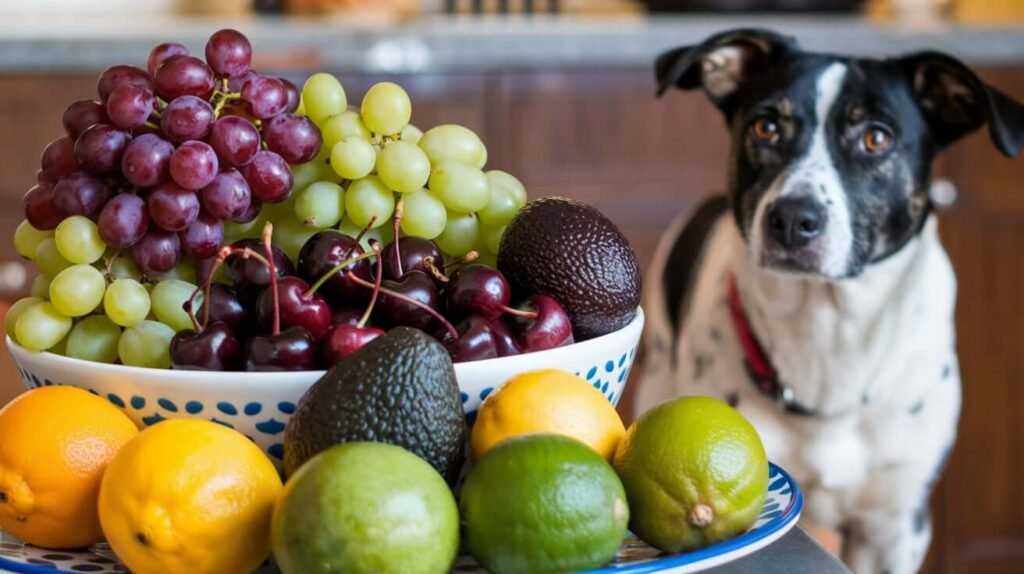Can Dogs Eat Clementines? 8 Powerful Nutritional Benefits
Can Dogs Eat Clementines? Yes, dogs can eat clementines in moderation. These juicy, sweet citrus fruits are safe for dogs when given in small amounts. However, it’s important to ensure your furry friend doesn’t consume too much, as the natural sugars and acidity in clementines can upset their stomach. Always peel the fruit, remove the seeds, and introduce it gradually to your dog’s diet to avoid any adverse reactions. While clementines can provide a boost of vitamin C and hydration, they should only be an occasional treat, not a regular part of their diet.

In this article, we’ll dive into whether or not your dogs can eat clementines safely, the potential benefits and risks, and how to safely introduce this fruit into your dog’s diet.
Table of Contents
- What Are Clementines?
- Are Clementines Good for Dogs?
- Benefits of Clementines for Dogs
- Clementines and Dog Digestion
- How Much Clementine Can a Dog Eat?
- How to Safely Feed Clementines to Dogs
- Is it bad for me to give my dog clementines?
- Can Dogs Eat Clementines Seeds
- Can Dogs Eat Tangerines Or Clementines
- Can Dogs Eat Oranges Peels
- Can Dogs Eat Clementines And Fruits : Alternatives To Clementines For Dogs
- General Guidelines for Feeding Fruits to Dogs:
- Recipe: Dog-Friendly Clementine Treats
- Some Common Questions Related to Can Dogs Eat Clementine
- 1. Can Dogs Eat Clementine with Apples?
- 2. Can Dogs Eat Mandarin Oranges with Clementine?
- 3. Can Dogs Eat Clementine with Strawberries?
- 4. Can Dogs Eat Bananas with Clementine?
- 5. Can Dogs Eat Orange Peels with Clementine?
- 6. Can Dogs Eat Clementine with Satsumas?
- 7. Can Dogs Eat Clementine with Watermelon?
- 8. Can Dogs Eat Clementine with Grapes?
- Summary:
- What to Do if Your Dog Eats Too Many Clementines
- When to Call the Vet
- Can Dogs Eat Clementines? What American Pets Universities and Pets Labs Say?
- Conclusion: Should Dogs Eat Clementines?
- FAQs about Can Dogs Eat Clementines
What Are Clementines?
Clementines are a type of small, seedless citrus fruit, often referred to as “easy peelers” because of their smooth, loose skin. They are a hybrid between a mandarin orange and a sweet orange, known for their vibrant orange color and sweet, tangy flavor. Commonly enjoyed as a snack or in fruit salads, clementines are rich in vitamin C, antioxidants, and water.
Are Clementines Good for Dogs?
Yes, clementines are generally safe for dogs to eat in moderation, but there are a few considerations to keep in mind:

Nutritional Value of Clementines for Dogs
Clementines are a small, sweet variety of citrus fruit, packed with essential nutrients that are beneficial to humans. However, when considering them for dogs, it’s important to evaluate both the potential benefits and risks. Let’s break down the key components of clementines and how they impact your canine friend.
1. Calories (47 per 100g)
Clementines are relatively low in calories, making them a low-calorie treat option for dogs when given in moderation. This can be helpful if you’re watching your dog’s weight or if they need a treat that won’t significantly increase their daily calorie intake.
2. Protein (0.8g per 100g)
Clementines contain a small amount of protein, but it’s not a significant source for dogs. Protein is essential for dogs’ muscle growth and repair, but they primarily get this from meat and animal-based foods. So, while the protein in clementines isn’t harmful, it doesn’t contribute much to their overall protein needs.

3. Carbohydrates (8.2g per 100g)
The carbohydrates in clementines come from natural sugars and fiber. While dogs don’t need as many carbohydrates as humans, the small amount in a piece of clementine isn’t harmful in moderation. However, dogs with diabetes or those prone to weight gain should have limited exposure to fruits high in sugar like clementines.
4. Dietary Fiber (1.7g per 100g)
Fiber plays a key role in digestion, and the fiber content in clementines can help promote gut health in dogs. It aids in regular bowel movements and can prevent constipation. However, too much fiber can cause digestive upset, including diarrhea or bloating, especially in smaller dogs.
5. Sugars (8.2g per 100g)
The high sugar content in clementines can be a concern. While natural sugars are healthier than processed ones, too much sugar can lead to weight gain, dental issues, or blood sugar spikes, particularly in dogs that are overweight or have diabetes. Therefore, clementines should be given in moderation to avoid these problems.
6. Vitamin C (48.8mg per 100g, 81% of the daily recommended intake for humans)
Vitamin C is vital for the immune system and skin health in humans. Interestingly, dogs can synthesize their own vitamin C, so they don’t need it from external sources like humans do. That said, a small amount of extra vitamin C from clementines isn’t harmful and may benefit older dogs or those under stress, as their ability to produce vitamin C can diminish over time.

7. Calcium (43 mg per 100g)
Calcium is crucial for strong bones and teeth in dogs, just as it is in humans. Clementines provide a small amount of calcium, but this amount is unlikely to make a significant impact on a dog’s calcium intake. Dogs get most of their required calcium from their regular diet, especially from high-quality dog food.
8. Potassium (177 mg per 100g)
Potassium is an essential mineral that supports heart health, muscle function, and nerve transmission. The potassium content in clementines can contribute to maintaining these vital functions in dogs. It’s especially beneficial for dogs that may need extra potassium, such as those with certain heart conditions or kidney issues, but again, only in moderation.
Potential Risks of Feeding Clementines to Dogs
- Digestive Upset: The citric acid in clementines may cause vomiting or diarrhea in some dogs, particularly if they eat too much.
- High Sugar Content: Overconsumption of sugary fruits like clementines can lead to weight gain, dental issues, and complications in diabetic dogs.
- Peels and Seeds: Clementine peels are tough to digest and can lead to gastrointestinal blockages or upset, while seeds (if present) can pose a choking hazard and may contain trace amounts of harmful substances.

Benefits of Clementines for Dogs
In small quantities, clementines can offer some benefits for dogs:
- Hydration: The high water content in clementines can help keep your dog hydrated, especially in warm weather.
- Vitamin C Boost: Although dogs naturally produce vitamin C, a little extra from fruits like clementines can provide an immune system boost in some situations, especially for older or stressed dogs.
- Low-Calorie Treat: Clementines can serve as a low-calorie treat option, which might be useful if you’re trying to manage your dog’s weight.
Clementines and Dog Digestion
How Dogs Digest Fruits
Dogs process food differently than humans, and their digestive systems are primarily designed for meat-based diets. However, dogs can digest certain fruits in moderation. Clementines, like other fruits, provide fiber, but too much can lead to stomach upset.

Can Dogs Handle Citrus Fruits?
Citrus fruits like clementines are generally safe for dogs in small amounts. However, the acidic nature of citrus can sometimes irritate a dog’s gastrointestinal tract. It’s important to introduce these fruits gradually and observe how your dog reacts.
How Much Clementine Can a Dog Eat?
Serving Size Guidelines
When offering clementines to your dog, moderation is key. For small dogs, one or two segments of clementine should be more than enough. Larger dogs may be able to tolerate a little more, but it’s still best to start with a small portion and see how your dog responds.

Frequency of Feeding Clementines to Dogs
Clementines should not be a regular part of your dog’s diet. Think of them as an occasional treat rather than a daily snack. A few segments once a week should suffice for most dogs.
How to Safely Feed Clementines to Dogs
Preparing Clementines for Dogs
If you decide to give your dog a clementine, here’s how to do it safely:
- Peel the Fruit: Remove the peel entirely, as it can be difficult for dogs to digest.
- Check for Seeds: Although clementines are typically seedless, double-check to ensure there are no seeds.
- Cut into Small Pieces: Cutting the fruit into small segments makes it easier for your dog to chew and digest.

Things to Avoid When Giving Clementines
- No Peels: The peel can be tough to digest and may cause stomach upset.
- Watch for Sugary Overload: Avoid giving clementines too frequently due to their sugar content.
- Monitor Your Dog’s Reaction: Keep an eye out for any signs of gastrointestinal distress, such as vomiting or diarrhea.
Is it bad for me to give my dog clementines?
Giving your dog clementines in moderation is generally not bad, but it’s important to follow some guidelines to keep it safe:
- Moderation is Key: Clementines are high in sugar and can cause digestive upset or weight gain if given too frequently. A small amount (like one or two segments) occasionally is fine for most dogs.
- Remove the Peel and Seeds: The peel contains essential oils that can be harmful to dogs, and the seeds could pose a choking hazard or cause digestive issues. Always remove them before offering the fruit to your dog.
- Watch for Reactions: Like with any new food, it’s important to introduce clementines gradually and watch for any signs of digestive upset (such as diarrhea or vomiting). If your dog has a sensitive stomach or is prone to certain health conditions (like diabetes), it’s best to avoid clementines altogether.
- Consider Your Dog’s Size and Health: Smaller dogs are more likely to experience digestive issues from sugary fruits, so they should only have very small portions.
Can Dogs Eat Clementines Seeds
No, dogs should not eat clementine seeds. While clementines are typically seedless, if you come across one that contains seeds, it’s important to remove them before giving the fruit to your dog.
Here’s why clementine seeds can be harmful:
- Choking Hazard: The small size of clementine seeds can pose a choking risk, especially for smaller dogs.
- Digestive Issues: Seeds can be difficult for dogs to digest and may cause gastrointestinal blockages or discomfort.
- Toxicity Concerns: Some citrus seeds, though not highly toxic, can still contain small amounts of compounds that are not good for dogs, like cyanogenic glycosides, which can cause mild toxicity in large amounts.
To keep your dog safe, always ensure the clementines are seedless or remove any seeds before offering them as a treat.
Can Dogs Eat Tangerines Or Clementines
Yes, dogs can eat both tangerines and clementines, but in moderation. Both of these fruits are part of the citrus family and share many similarities, including being small, sweet, and easy to peel. While they are not toxic to dogs, there are a few things to consider before feeding them to your pet:
Benefits:
- Hydration: Both fruits are high in water content, which can help keep your dog hydrated.
- Vitamin C: Dogs produce their own vitamin C, but a small boost from these fruits may benefit some, especially older or stressed dogs.
- Low-Calorie Treat: They are a low-calorie option for an occasional treat.

Risks:
- High Sugar Content: Both tangerines and clementines contain natural sugars, which can be problematic for dogs, especially those prone to obesity, diabetes, or other health conditions.
- Acidity: The citric acid in these fruits may upset your dog’s stomach, leading to vomiting or diarrhea if consumed in large amounts.
- Peels and Seeds: Although clementines are usually seedless, tangerines may contain seeds, and both have peels that are tough to digest and can cause gastrointestinal issues or blockages.
How to Feed Them Safely:
- Remove the peel and any seeds (if present).
- Offer only a few segments at a time to avoid overfeeding.
- Watch for any signs of digestive upset, especially if it’s the first time your dog has tried these fruits.
Can Dogs Eat Oranges Peels
No, dogs should not eat orange peels. While oranges themselves can be safe for dogs in small amounts, the peel poses several risks:
- Hard to Digest: Orange peels are tough and fibrous, making them difficult for dogs to digest. Eating the peel could lead to gastrointestinal upset, including vomiting, diarrhea, or constipation.
- Potential for Blockages: Because of their fibrous texture, orange peels can cause blockages in your dog’s digestive system, especially if a large amount is consumed.
- Chemical Residues: Many oranges are treated with pesticides or other chemicals, and these residues can remain on the peel, potentially harming your dog if ingested.
Can Dogs Eat Clementines And Fruits : Alternatives To Clementines For Dogs

Can Dogs Eat Other Fruits?
There are many fruits that dogs can enjoy safely, but not all are suitable. Let’s look at a variety of fruits, their benefits, and any associated risks:
Safe Fruits for Dogs:
- Apples (without seeds or core):
- Benefits: Apples are a great source of vitamins A and C, and they provide fiber, which can help with digestion. They are also low in calories.
- Risks: Apple seeds contain cyanide, which is toxic to dogs if consumed in large quantities, so always remove the seeds and core.
- Bananas:
- Benefits: Bananas are rich in potassium, fiber, and vitamins like B6 and C. They are good for heart health and digestive regularity.
- Risks: Because bananas are high in sugar, they should be fed in moderation, especially to dogs that are overweight or prone to diabetes.
- Strawberries:
- Benefits: Strawberries are high in antioxidants, fiber, and vitamin C. They can support immune health and are low in calories.
- Risks: While generally safe, strawberries should be fed in moderation due to their sugar content.
- Blueberries:
- Benefits: Blueberries are an excellent source of antioxidants and vitamins, which can support a dog’s immune system and brain health.
- Risks: No significant risks, but as with any treat, they should be fed in moderation.
- Watermelon (without seeds or rind):
- Benefits: Watermelon is mostly water, making it a hydrating treat for dogs, especially in hot weather. It’s also rich in vitamins A, B6, and C.
- Risks: The seeds and rind should be removed, as they can cause digestive issues or blockages.
- Pineapple (without the core or skin):
- Benefits: Pineapple is high in vitamins and hydration. It also contains bromelain, an enzyme that can help break down proteins, aiding digestion.
- Risks: The core and skin should be avoided as they are tough and can cause digestive blockages.

Fruits That Are Unsafe for Dogs:
- Grapes and Raisins:
- Risks: Grapes and raisins are toxic to dogs and can cause kidney failure, even in small amounts. It’s essential to avoid these fruits entirely.
- Cherries (especially the pits):
- Risks: Cherry pits contain cyanide, which is toxic to dogs. Even without the pits, cherries should be fed with caution, as they can upset a dog’s stomach.
- Avocados:
- Risks: Avocados contain persin, a toxin that can cause vomiting and diarrhea in dogs. The pit is also a choking hazard.
- Lemons and Limes:
- Risks: While not usually toxic in small amounts, the high citric acid content in lemons and limes can irritate a dog’s digestive system, leading to vomiting or diarrhea.

General Guidelines for Feeding Fruits to Dogs:
- Moderation is Key: Even with safe fruits, too much can cause digestive issues or lead to excessive sugar intake.
- Remove Seeds, Pits, and Peels: Always remove any seeds, pits, or tough peels, as they can pose choking hazards or cause blockages.
- Introduce Slowly: If it’s the first time you’re offering a new fruit to your dog, introduce it gradually to watch for any adverse reactions.
- Fresh or Frozen, but Not Canned: Fresh or frozen fruits are best for dogs. Avoid canned fruits, as they often contain added sugars or preservatives.
Recipe: Dog-Friendly Clementine Treats
1. Clementine & Yogurt Frozen Treats
Ingredients:
- 2 seedless clementines (peeled and segmented)
- 1 cup plain, unsweetened Greek yogurt
- 1/4 cup water
Instructions:
Blend all ingredients until smooth, pour into molds, freeze for 4 hours, and serve!
2. Clementine & Peanut Butter Cookies
Ingredients:
- 2 seedless clementines (peeled and juiced)
- 1/4 cup peanut butter (ensure xylitol-free)
- 1 cup oat flour
- 1 egg
Instructions:
Mix all ingredients, roll into balls, flatten slightly, and bake at 325°F (165°C) for 20 minutes.

3. Clementine & Carrot Mini Muffins
Ingredients:
- 2 seedless clementines (juiced)
- 1/2 cup grated carrots
- 1 cup whole wheat flour
- 1 egg
- 1/4 cup olive oil
Instructions:
Mix wet ingredients, fold in dry ingredients, pour into mini muffin tins, and bake at 350°F (175°C) for 18-20 minutes.
4. Clementine & Oatmeal Dog Biscuits
Ingredients:
- 1 cup rolled oats
- 2 seedless clementines (peeled and juiced)
- 1/4 cup unsweetened applesauce
Instructions:
Mix all ingredients into a dough, shape into biscuits, and bake at 325°F (165°C) for 25 minutes.
5. Clementine & Sweet Potato Bites
Ingredients:
- 1 cup mashed sweet potato
- 2 seedless clementines (juiced)
- 1/4 cup oat flour
Instructions:
Mix ingredients, scoop into small balls, flatten slightly, and bake at 350°F (175°C) for 20 minutes.
6. Clementine & Banana Smoothie Treats
Ingredients:
- 1 clementine (peeled and segmented)
- 1/2 banana
- 1 cup plain, unsweetened yogurt
Instructions:
Blend all ingredients, pour into molds, freeze, and serve as refreshing treats.

7. Clementine & Chicken Jerky Glaze
Ingredients:
- 1 clementine (juiced)
- 1/4 cup low-sodium chicken broth
- 1 tablespoon honey (optional)
Instructions:
Brush the mixture onto chicken jerky strips before drying in a dehydrator or oven at 200°F (95°C) for 3 hours.
8. Clementine & Pumpkin Biscuits
Ingredients:
- 1 cup canned pumpkin (unsweetened)
- 2 seedless clementines (juiced)
- 1/2 cup oat flour
- 1 egg
Instructions:
Combine ingredients, shape into cookies, and bake at 325°F (165°C) for 20-25 minutes.
Some Common Questions Related to Can Dogs Eat Clementine
1. Can Dogs Eat Clementine with Apples?
Yes, dogs can safely eat clementines with apples, provided they are prepared correctly and served in moderation. Both fruits offer health benefits, but there are precautions to ensure they remain safe for your dog.
2. Can Dogs Eat Mandarin Oranges with Clementine?
Yes, dogs can eat mandarin oranges and clementines together in small amounts. Both are safe citrus fruits when peeled and seedless. However, due to their acidity and natural sugars, limit the serving to a few segments to avoid stomach upset.
3. Can Dogs Eat Clementine with Strawberries?
Yes, strawberries and clementines can be safely combined for dogs. Both are rich in vitamins and antioxidants, making them a nutritious treat. Ensure the clementines are peeled and seedless, and strawberries are washed and cut into small pieces.
4. Can Dogs Eat Bananas with Clementine?
Yes, bananas and clementines can be eaten together by dogs. Bananas provide potassium and fiber, while clementines add vitamin C. Serve in small quantities as a refreshing and healthy snack.

5. Can Dogs Eat Orange Peels with Clementine?
No, dogs should not eat orange peels or clementine peels. The peels are tough to digest and can cause gastrointestinal upset or blockages. Always remove the peel before offering the fruit to your dog.
6. Can Dogs Eat Clementine with Satsumas?
Yes, clementines and satsumas are both safe for dogs when peeled and seedless. These citrus fruits are similar in flavor and nutrients, but limit the portion to avoid stomach upset from acidity.
7. Can Dogs Eat Clementine with Watermelon?
Yes, clementines and watermelon can be safely combined for dogs. Watermelon is hydrating and low-calorie, while clementines add a vitamin boost. Ensure the watermelon is seedless and rind-free.
8. Can Dogs Eat Clementine with Grapes?
No, dogs should never eat grapes with clementines or alone. Grapes are highly toxic to dogs and can cause kidney failure, even in small amounts. Always keep grapes out of their diet.
Summary:
- Safe in moderation: Apples (remove seeds), Mandarin Oranges (no peel), Strawberries, Bananas, Satsumas (no peel), Watermelon (no seeds or rind)
- Not Safe: Mandarin Orange Peels, Orange Peels, Grapes
What to Do if Your Dog Eats Too Many Clementines
Signs of Overeating Clementines
If your dog consumes too many clementines, they may experience:
- Vomiting
- Diarrhea
- Stomach discomfort
Watch for these signs and take action if necessary.

When to Call the Vet
If your dog shows persistent symptoms after eating clementines, such as prolonged vomiting or diarrhea, it’s best to consult your veterinarian. While clementines are not highly toxic, too much citrus can lead to significant digestive issues.
Can Dogs Eat Clementines? What American Pets Universities and Pets Labs Say?
Dogs can safely eat the flesh of clementines in small amounts, but there are important precautions to consider. Clementines contain beneficial nutrients like vitamin C, potassium, and fiber, which can support your dog’s health when offered in moderation. However, there are a few potential risks:
- Sugar Content: Clementines are relatively high in natural sugars, which, if given in excess, can contribute to weight gain or gastrointestinal upset.
- Citrus Acidity: The citric acid in clementines may cause stomach upset or diarrhea, especially in dogs with sensitive stomachs.
- Peels and Seeds: The peel and seeds of clementines can be harmful, as they may cause digestive issues or even toxicity in some dogs.

It’s important to remove the peel and seeds before offering any clementine to your dog. Start with a small piece and observe how your dog reacts to the fruit.
For puppies, it’s advisable to avoid introducing citrus fruits too early, as their sensitive stomachs might not handle the acidity well. Always consult your veterinarian before adding new foods to your dog’s diet, especially if they have specific health issues or dietary needs
Conclusion: Should Dogs Eat Clementines?
So, can dogs eat clementines? Yes, but only in moderation. While they can offer some health benefits like hydration and a vitamin C boost, they also come with risks, particularly due to their sugar content and acidity. Always introduce new foods gradually and monitor your dog for any adverse reactions. Clementines can be a fun, occasional treat, but they should never replace a well-balanced dog diet.
FAQs about Can Dogs Eat Clementines
Can dogs eat clementine peels?
No, dogs should not eat clementine peels. The peel contains essential oils that can cause digestive upset or even toxicity in large amounts. It’s also tough for dogs to digest, which can lead to choking or blockages.
How much clementine can I give my dog?
One or two small segments should be enough for a small dog. Larger dogs may be able to handle more, but it’s important to limit the amount due to the fruit’s sugar content.
Can clementines cause diarrhea in dogs?
Yes, if consumed in excess, the sugar and acidity in clementines can upset your dog’s stomach and lead to diarrhea or other digestive issues.
Are there any risks of feeding dogs clementines?
While clementines are generally safe, there are risks if consumed in large amounts, including digestive problems, weight gain, or high blood sugar. Always remove the peel and seeds before feeding.
Can puppies eat clementines?
Puppies can have small amounts of clementines, but it’s best to wait until they’re a little older and their digestive system is more developed. Always introduce new foods gradually and watch for any signs of an upset stomach.







